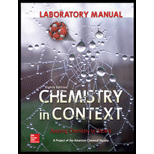
Concept explainers
(a)
Interpretation:
The mass percent of chlorine in
Concept Introduction:
Molar mass: It is obtained by dividing the mass of substance with the amount of substance and the S.I. unit of molar mass is
Molar mass of
Mass ratio of a compound with formula AB can be determined as follows,
Mass percentage will give an idea about how many parts exist in every 100 parts of the whole substance.
Mass percentage of a compound with formula AB can be determined as follows,
(a)
Explanation of Solution
Given molecule is
Molar mass of chlorine is 35.5 g/mol and there are three chlorine atoms in the given Freon-11 molecule.
The mass percent of chlorine in
(b)
Interpretation:
Interpretation:
The mass percent of chlorine in
Concept Introduction:
Molar mass: It is obtained by dividing the mass of substance with the amount of substance and the S.I. unit of molar mass is
Molar mass of
Mass ratio of a compound with formula AB can be determined as follows,
Mass percentage will give an idea about how many parts exist in every 100 parts of the whole substance.
Mass percentage of a compound with formula AB can be determined as follows,
(b)
Explanation of Solution
Given molecule is
Molar mass of chlorine is 35.5 g/mol and there are three chlorine atoms in the given Freon-12 molecule.
The mass percent of chlorine in
(c)
Interpretation:
The maximum mass of chlorine that could be released in the stratosphere by 100 g of Freon-11 and Freon -12 has to be calculated.
Concept Introduction:
Molar mass: It is obtained by dividing the mass of substance with the amount of substance and the S.I. unit of molar mass is
Molar mass of
Mass ratio of a compound with formula AB can be determined as follows,
Mass percentage will give an idea about how many parts exist in every 100 parts of the whole substance.
Mass percentage of a compound with formula AB can be determined as follows,
(c)
Explanation of Solution
The mass percentage of chlorine in Freon-11 and Freon -12 are
And so, the maximum mass of chorine that could be released in the stratospher by 100 g of each compound will be 77.5 g and 58.7 g respectively.
(d)
Interpretation:
The number of atoms in 77.5 g and 58.7 g of chlorine has to be determined.
Concept Introduction:
Molar mass: It is obtained by dividing the mass of substance with the amount of substance and the S.I. unit of molar mass is
The relation between the number of moles and mass of the substance is,
(d)
Explanation of Solution
The mass percentage of chlorine in Freon-11 and Freon -12 are
And so, the maximum mass of chorine that could be released in the stratospher by 100 g of each compound will be 77.5 g and 58.7 g respectively.
The number of chlorine atoms in these masses can be calculated as follows,
In Freon-11
In Freon-12
Want to see more full solutions like this?
Chapter 3 Solutions
Laboratory Manual Chemistry in Context
- Explain the difference between the effects of ground- level ozone and stratospheric ozone. Why is one beneficial to human life, whereas the other is not?arrow_forwardWhy does ozone deplete severely over Antarctica each October, but not over other areas of the planet?arrow_forwardWhy are oxygen and nitrogen important gases in our atmosphere?arrow_forward
- Which of the following is responsible for the rise in temperature in the stratosphere? a. height of the stratosphere b. position of the stratosphere c. presence of the ozone d. nearness to the sunlightarrow_forwardDescribe why ozone is more reactive than oxygen gas?arrow_forward9. Which of these is the most common greenhouse gas released by outgasing?arrow_forward
- Q/a-Draw the molecular formula of nitrous oxide. b-Use the molecular motion, why this molecule is able to absorb IR energy? c- What is the major source of nitrous oxide in the troposphere?arrow_forward11.5. a) Why do oxygen atoms exist longer at 120-km altitude than at 50-km altitude? b) What is the biological significance of the stratospheric ozone layer at Earth’s surface?arrow_forward

 Chemistry & Chemical ReactivityChemistryISBN:9781337399074Author:John C. Kotz, Paul M. Treichel, John Townsend, David TreichelPublisher:Cengage Learning
Chemistry & Chemical ReactivityChemistryISBN:9781337399074Author:John C. Kotz, Paul M. Treichel, John Townsend, David TreichelPublisher:Cengage Learning Chemistry & Chemical ReactivityChemistryISBN:9781133949640Author:John C. Kotz, Paul M. Treichel, John Townsend, David TreichelPublisher:Cengage Learning
Chemistry & Chemical ReactivityChemistryISBN:9781133949640Author:John C. Kotz, Paul M. Treichel, John Townsend, David TreichelPublisher:Cengage Learning Chemistry for Engineering StudentsChemistryISBN:9781285199023Author:Lawrence S. Brown, Tom HolmePublisher:Cengage LearningChemistry: Matter and ChangeChemistryISBN:9780078746376Author:Dinah Zike, Laurel Dingrando, Nicholas Hainen, Cheryl WistromPublisher:Glencoe/McGraw-Hill School Pub Co
Chemistry for Engineering StudentsChemistryISBN:9781285199023Author:Lawrence S. Brown, Tom HolmePublisher:Cengage LearningChemistry: Matter and ChangeChemistryISBN:9780078746376Author:Dinah Zike, Laurel Dingrando, Nicholas Hainen, Cheryl WistromPublisher:Glencoe/McGraw-Hill School Pub Co General Chemistry - Standalone book (MindTap Cour...ChemistryISBN:9781305580343Author:Steven D. Gammon, Ebbing, Darrell Ebbing, Steven D., Darrell; Gammon, Darrell Ebbing; Steven D. Gammon, Darrell D.; Gammon, Ebbing; Steven D. Gammon; DarrellPublisher:Cengage Learning
General Chemistry - Standalone book (MindTap Cour...ChemistryISBN:9781305580343Author:Steven D. Gammon, Ebbing, Darrell Ebbing, Steven D., Darrell; Gammon, Darrell Ebbing; Steven D. Gammon, Darrell D.; Gammon, Ebbing; Steven D. Gammon; DarrellPublisher:Cengage Learning





